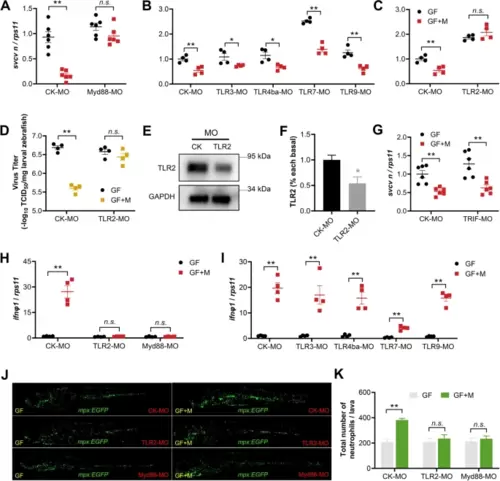Fig. 4
- ID
- ZDB-FIG-241212-4
- Publication
- Liang et al., 2024 - The intestinal microbiome and Cetobacterium somerae inhibit viral infection through TLR2-type I IFN signaling axis in zebrafish
- Other Figures
- All Figure Page
- Back to All Figure Page
|
The antiviral effect of intestinal microbiota requires TLR2 and Myd88 signaling. A Effect of Myd88 knockdown on SVCV infection in GF or conventionalized zebrafish at 48 hpi (n = 6, pool of 30 zebrafish larvae per sample). B Effect of morpholino-mediated knockdown of TLR3, TLR4ba, TLR7, and TLR9 on SVCV infection in GF or conventionalized zebrafish at 48 hpi (n = 4, pool of 30 zebrafish larvae per sample). C–D Effect of TLR2 knockdown on SVCV infection in GF or conventionalized zebrafish at 48 hpi (n = 4, pool of 30 zebrafish larvae per sample). E–F TLR2 morpholino diminished TLR2 protein expression in zebrafish larvae (n = 3, pool of 30 zebrafish larvae per sample). G Effect of TRIF knockdown on SVCV infection in GF or conventionalized zebrafish at 48 hpi (n = 6, pool of 30 zebrafish larvae per sample). Effect of morpholino-mediated knockdown of TLR2, Myd88 (H), TLR3, TLR4ba, TLR7, and TLR9 (I) on IFNΦ1 expression in GF or conventionalized zebrafish at 48 hpi (n = 4, pool of 30 zebrafish larvae per sample). J–K Effect of morpholino-mediated knockdown of TLR2 and Myd88 on neutrophil response in GF or conventionalized Tg (mpx:EGFP) zebrafish at 48 hpi. J Confocal imaging of SVCV-infected Tg (mpx:EGFP) zebrafish. Scale bar, 500 μm. K Neutrophil numbers (n = 3). A–D, F–I, K Unpaired t-test. *p < 0.05, **p < 0.01, n.s., not significant |

